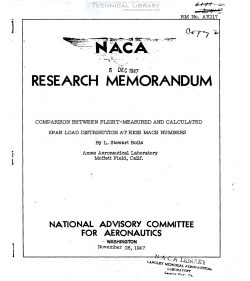naca-rm-a7g17
- Version
- 90 Downloads
- 665.09 KB File Size
- 1 File Count
- April 20, 2017 Create Date
- April 20, 2017 Last Updated
National Advisory Committee for Aeronautics, Research Memorandum - Comparison Between Flight-Measured and Calculated Span Load Distribution at High Mach Numbers

The spam-rise loading has been computed, by two different
methods, on the wing of an airplane for which pressure-distribution
measurements were available from flight tests up to a Mach number of
0.866. One set of the calculations was based on a generalized
method of the lifting—line theory utilizing high—speed wind—tunnel
data, while the other set employs an approximate semielliptical
distribution. The comarison between the measured and calculated
distributions has been made on the basis of equal wing—panel normal—
force coefficients.
To obtain a valid comparison it was necessary to consider the
upfloat of the aileron which occurred. at the higher Mach numbers.
A fairly close agreement was obtained by both methods for these
conditions, especially at the highest values of 01v considered. 'It
was shown that, up to 0.866 Mach number, neglect of aileron upfloat
in span load calculations might produce a. more serious shift in the
span load distribution than. would occur from nonconsideration of the
compressibility effects on the section lift—curve slope and angle of
zero lift.
A great deal of consideration has been given to the accuracy
of computed span load distribution at high speeds due to the change
in the distribution occurring at high Mach numbers. Recentl , _
measurements of the wing pressure distributions have been made on a
jet—propelled airplane in flight up to- a Mach mimber of 0.866
(reference 1). These data have given an opportunity 'for checking
the accuracy of methods of cemputing highs-speed span load distribu—
tion. This report presents comparisons between measured span load
and span load as computed by two methods.
In the first case- the comparison was made between measured span
load. distributions and. calculated values, using the method of
reference 2 a generalized method by which the effects of cmprzrse-
i'bili ty and abrupt twist are treated; be a process of successive
approximations utilizing section data. The high—speed section date.
necessary for this method of calculating span 10': (1 distribution was
obtained. from the results of tests in the Ames 1—. by 3.1/2—foot
highwspeed wind tunnel.
| File | Action |
|---|---|
| naca-rm-a7g17 Comparison Between Flight-Measured and Calculated Span Load Distribution at High Mach Numbers.pdf | Download |

Comment On This Post